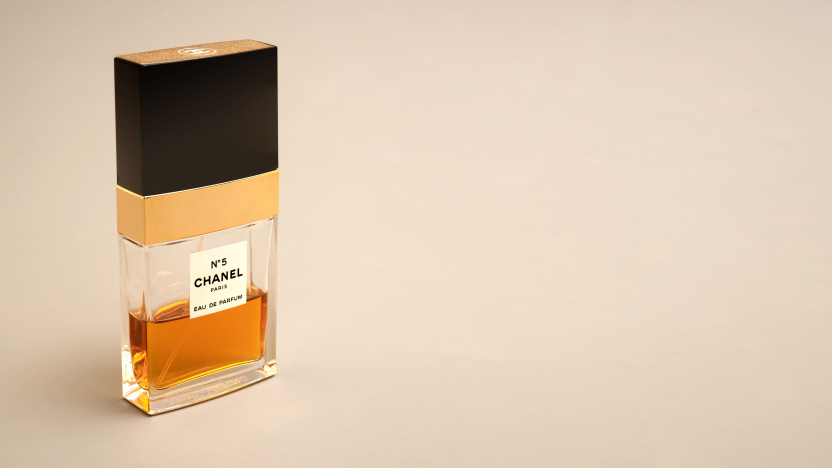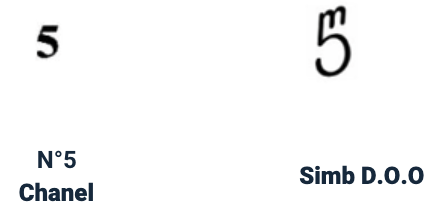Can you register a number as a trademark in the EU?

The recent dispute over the Chanel N°5 trademark raises the question of whether you can register a number as a trademark in the EU. Clarisse Merdy provides some helpful guidance on numeric trademarks and figurative trademark rights.
This case pits the famous fashion house Chanel, against the Slovak company Simb DOO. The first, owner of the French trademarks ‘N°5’ (No 1293767) and ‘5’ (No 98755754), had filed an opposition against the (European) figurative trademark application (No 18872562) by Simb DOO (as shown below).

In its argument, Maison Chanel requested the rejection of Simb DOO’s figurative trademark application, highlighting the distinctive character and reputation of ‘N°5’, its world-famous perfume brand. It also argued that – due to the dominant character of the number ‘5’ – the similarity between the signs was obvious, as was that of the goods in question, designated in class 3. Simb defended its application, emphasising its distinctive character, its originality and the absence of confusion between the signs.
Accordingly, the European Union IP Office (EUIPO) had to examine the likelihood of confusion; namely, whether the contested application was sufficiently distinctive in relation to ‘N°5’, and subsequently, whether the reputation of the Chanel trademark justified extended protection.
Numeric trademarks: EUIPO's position in this case
While the EUIPO acknowledged the similarity between the goods designated in class 3 by the conflicting trademarks, it did not acknowledge the similarity between the signs, noting: "the differences between the signs are striking and will be remembered."
On the basis of the evidence submitted by the opponent, EUIPO also held: "there is no evidence as to how, when and where the advertising materials were distributed; in particular, if they ever reached consumers in the relevant territory, or if the marketing campaigns were limited to other geographical areas of the world […] the evidence on file is not sufficient to prove a level of distinctiveness above the normal degree of inherent distinctiveness of the earlier marks," and concluded: "The earlier (trade) marks as a whole, have no meaning for any of the goods in question from the perspective of the public in the relevant territory. Therefore, their distinctiveness must be seen as normal."
Proving trademark distinctiveness
This decision is based on a rigorous and severe logic of assessment of the distinctive character of trademarks.
The EUIPO recalled the principle guiding its case law. Indeed, despite the reputation of the trademark ‘N°5’, which has designated luxury perfumes since 1921 and which could therefore appear to be universally present in the minds of consumers, it is necessary to prove this reputation: "The Opposition Division must disregard any private knowledge it might have of the enhanced distinctiveness of the earlier trademarks and limit its assessment solely to the evidence on file.”
The stakes of this assessment are important insofar as the risk of confusion is all the higher as the distinctive character of the earlier trademark proves to be important (Sabèl). Subsequently, marks whose distinctive character is recognised as increased enjoy more extensive legal protection (Canon).
As we will have understood, this privilege is not, however, innate, as companies must provide concrete and substantial evidence relating to the designated products and services, such as:
- Evidence of use of the trademark: this may include documents showing the duration, intensity and geographical extent of the exploitation of the trademark among consumers
- Market research: highlighting brand recognition among consumers
- Sales figures: indicating the commercial success of the brand
- Advertising and promotion: Highlighting marketing investments and advertising campaigns that demonstrate the effort to maintain and increase awareness
- Awards and distinctions: attesting to professional and public recognition
- Media presence: This can include press articles, media appearances, and references in publications showing brand exposure.
The distinctiveness assessment
It is necessary to bear in mind that distinctiveness is relevant in various contexts, such as when assessing the likelihood of confusion or harm to reputation, but it should not interfere with the strict analysis of the similarity of signs and will only be recognised as high if it can be demonstrated by concrete evidence.
Companies must ensure, therefore, that they always provide substantial and convincing evidence to benefit from the legal protection of highly distinctive or even renowned trademarks, while ensuring that they do not confuse proof of “longevity” with that of “distinctiveness”… which unfortunately does not seem to have been the case for Chanel in this instance.
We can imagine that an appeal could be filed, which would allow this luxury house to argue the distinctiveness of its numeric trademarks.
To be continued!
To find out more about numeric trademarks, including whether it is possible to register a distinctive number as a trademark, speak to your Novagraaf consultant or contact us below.
Clarisse Merdy is a Trademark and Design Attorney at Novagraaf in Bordeaux.